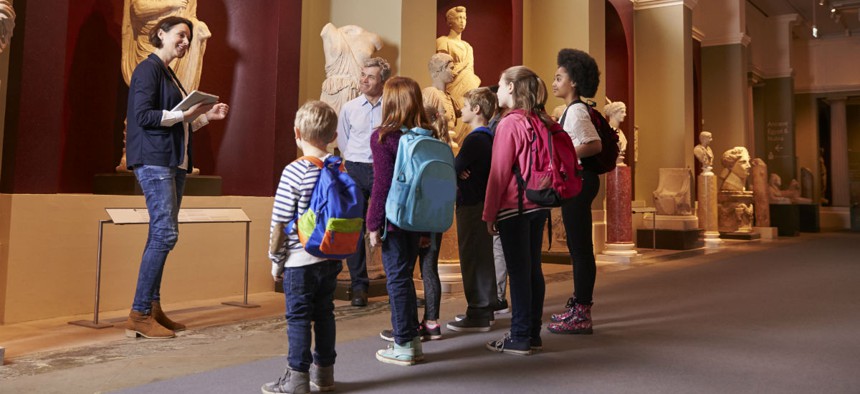
Arts and Humanities Agencies Brace for Familiar Threat of Extinction
The Trump administration’s reported plan for budget cuts prompts anxiety and pushback.
Employees at the National Endowment for the Humanities are worried.
Since word began spreading late last month that the Trump administration’s first draft budget would adopt long-standing conservative proposals for eliminating NEH and similar agencies, people “are living day to day,” said Talana Morton-Smith, vice president of Local 3403, the bargaining unit of the American Federation of Government Employees, which represents about half of NEA’s 160-member workforce.
“There’s plenty of potential there for anything to happen,” she told Government Executive. “We have staff members who are new mothers, and some who are putting children through college while I myself was supposed to retire next year. There’s a lot of uncertainty.”
Unlike employees at the National Park Service and the Environmental Protection Agency, few NEH staff are tweeting their discontent over the rumored plan to zero-out their $146 million annual budget. “My staff is very creative and love their jobs in spite of what’s going on, and are moving forward,” she said.
They’re not helped by the hiring freeze, “which puts a burden on the employees, who feel they’re short-staffed already,” she added. Many of them have been around long enough to recall the reductions in force in the mid-1990s under then-House Speaker Newt Gingrich and the Republican Contract with America.
Though reluctant to speak to reporters, Morton-Smith said, her colleagues will be closely watching the Interior Department appropriations bill in the continuing resolution expected this spring, which also funds the equally threatened National Endowment for Arts and the Institute of Museums and Libraries (whose annual budget is $230 million). “We don’t know what’s going to happen.”
The revival of a conservative budget that guns for the endowments—based on reports linking Trump to blueprints from the Heritage Foundation and the House Republican Study Group—may not necessarily reflect the thinking of President Trump and Vice President Mike Pence, though demands for deficit reduction and deference to the private marketplace may sway them.
Trump’s own foundation in the past has given money to arts organizations in New York City and West Palm Beach, according to news reports and advocacy groups. When the Washington Post last March asked candidate Trump what role the government should play in funding the endowments, he said Congress would make the determination.
“Knowing Trump’s background, I don’t think he comes out hating the endowments,” Jack Duncan, a longtime Capitol Hill Democratic aide who has served as counsel for arts organizations, told Government Executive. “His philosophy is not in line with some of the more conservative Republicans.”
Another possible mitigating factor may be Karen Pence’s work championing art therapy, some of whose practitioners receive NEA grants. The wife of Vice President Mike Pence has long supported the little-known occupation.
But Richard Ekman, president of the Council of Independent Colleges, whose members receive many NEH grants, said the advocacy groups “think it’s a little more serious than the other times when a conservative administration made a statement about getting rid of the endowments.” He points to the National Humanities Alliance, a coalition that is alarmed enough to begin marshaling arguments about the reach of endowment grants into many rural congressional districts and non-elite programs as grants that help veterans prepare for college.
Indeed, on Friday, 24 senators (including Republicans Shelly Moore Capito of West Virginia and Susan Collins of Maine) joined with Sen. Kirsten Gillibrand, D-N.Y., in writing to Trump to point out that the arts and humanities sector is a $704 billion industry, accounting for 4.2 percent of the nation’s gross domestic product. “The National Endowment for the Arts and National Endowment for the Humanities have proven invaluable in the growth of our cultural institutions that our families and children enjoy, learn from, and experience,” they said.
Tactically, Ekman said, “conservatives should favor supporting the endowments as an alternative to the much larger amounts of money that go to support the Education Department. By spending small amounts on a tough competitive [grants] process with prestige attached to it, you have stimulated educational change without the categorical funding Education throws at it.”
Small competitive grants bring “a lot of leverage” and high quality selection, he added, which brings agency matching funds and stimulates gifts from private donors—“assuming you want to do something to help the arts,” he said.
The other issue is whether a “western democracy should be doing something to support cultural advancement,” Ekman added. The endowments are “broad-gauged,” meaning they support a wide range of culture—“and not just in the home country,” he said, citing as examples grants for the traveling exhibits of Egypt’s King Tut exhibit and Ken Burns’ films. The endowments “are able to bring understanding of other parts of the world to vast numbers of Americans.”
Duncan, whose defense of arts, humanities and museum funding goes back to the 1960s, said long-standing resistance among conservatives “is probably amplified now because the arts world is defined by some people as Hollywood.” Referring to the tendency of actors to “spout off” politically at nationally televised awards ceremonies,” he said he wishes those actors “would think for five minutes.” Viewers often react by asking, “Why should the government give money to support those people?” Duncan said, “Those various demonstrations aren’t helping the cause.”
If Trump does take an ax to the endowments, there will be one ironic footnote: Though currently housed at the Constitution Center in Southwest Washington, both endowments until 2014 had their offices in Washington’s Old Post Office Building. When the General Services Administration struggled to find a full array of paying tenants, Congress pressured GSA to lease the building to the private sector. It’s now the Trump International Hotel.
NEXT STORY: Is the Southern Border a Constitution-Free Zone?







